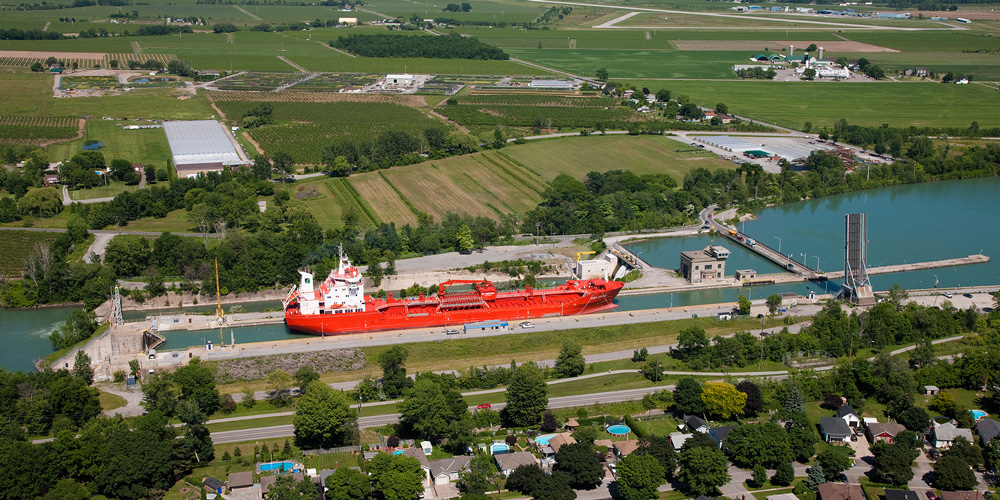#3 – General Notice
March 19, 2004
This notice cancels and supersedes all previous Seaway Notices and Regional Notices to Shipping issued prior to December 31, 2003.
1. EASTERN STANDARD TIME/DAYLIGHT SAVING TIME
The Seaway entities will be operating on Eastern Standard Time from the opening of the navigation season until 0200 hours on April 4, 2004, at which time Eastern Daylight Saving Time will become effective. At 0200 hours on October 31, 2004, the operating time will revert to Eastern Standard Time.
2. SEAWAY DRAFTS
Seaway Notice No. 2 – 2004 outlines the maximum permissible draft for the Montreal – Lake Ontario and Welland Canal sections respectively.
It is the responsibility of the master to ensure that the permissible drafts are not exceeded. Overdraft vessels create scheduling problems and are a source of delay to users, especially if discharge of cargo is required.
During hot weather, the masters must be aware of “hogging” conditions and allow for this within the permissible draft.
3. SPEED LIMITS
The speed limits indicated in Column III, of the attached schedule of speed limits, will be in effect as of the opening of the navigation season. Vessels must operate within the established speed limits. A speed enforcement program will be carried out throughout the navigation season. Refer to Seaway Notice No. 2 for further information.
4. VESSEL EQUIPMENT
Accidents and potentially serious incidents have occurred due to malfunctions of essential equipment and, sometimes, to the failure of ship personnel to understand their equipment. Mariners are reminded that:
- Generators that supply power to winches and/or bow thrusters must be operating and on line at all times. When automatic start emergency standby equipment is not available, watchkeeping engineers must be fully conversant with emergency changeover;
- Wrong-way propeller alarms, wrong-way pitch alarms and engine interlocks are essential safety devices that must be fully operational at all times during transit. It is important that a regular testing procedure, to verify the functioning of these installations, be established on board the vessel;
- In the interest of safety, it is essential that Part VII Sections 81, 84 and 85 of the Seaway Handbook, “Reporting of Accidents, Impairment or other Hazards by Vessels Transiting or Intending to Transit the Seaway” be strictly adhered to;
- While transiting the Seaway, the master of a ship shall immediately report to the nearest Seaway station any malfunction of the AIS transponder; Mariners are advised that the AIS unit must be operational when transiting Seaway waters. The AIS unit must transmit a DGPS signal and gyro heading. It is recommended that the following “Self-Checks” on the Minimum Keyboard Display (MKD) are performed prior to Seaway transit.
- Check the heading field to ensure that it is valid. If the heading is not indicated, the AIS unit is not transmitting a “gyro” heading as per IMO guidelines for installation.
- The AIS unit must be connected and transmit position from an external DGPS. Verify on the “GPS source” screen that the source is “External GNSS”, this should change automatically to “External DGNSS” when picking up local radio beacons.
On some systems “External GNSS” is indicated as “Secondary” while “External DGNSS” is indicated as “Primary”. Please consult your AIS operation manual.
Mariners are advised that the Minimum Keyboard Display (MKD) shall be located in such a manner that it will be visible day or night from the conning position.
- All vessels upbound for the Seaway must test the main propulsion machinery, ahead and astern no more than 24 hours before entering at CIP 2. A record of this test must be maintained on board;
- Ships using synthetic lines, in accordance with Part I Section 10 of the Seaway Handbook, shall not use nylon since its high elasticity can produce an extremely dangerous whipping effect if it breaks under stress.
5. OVERALL VESSEL DIMENSIONS
In recent years the design of the superstructure of vessels with machinery and accommodations aft has changed considerably and has generally resulted in an increase in the overall size of the afterhousing. As a result, the bridge wings, antenna masts and, in some cases, the samson posts or store cranes are outside the limits of the block diagram in Appendix 1 of the Seaway Handbook, should the stern of the vessel override the lock walls when exiting the locks.
Masters and pilots must take this condition into consideration and exercise extreme caution when exiting locks, to ensure that the vessel is maintained in proper lock alignment until finally passed and clear of all structures.
NOTE – Ships with beams greater than 23.20 m may be restricted/delayed during transits of the St. Lawrence Seaway during periods of ice cover.
Certain requirements must be met by vessels greater than 222.5 metres (O.A.L.):
- Vessels must have a rounded stem bar.
- Vessels must be equipped with adequately powered self-tensioning and self-rendering winches and fairleads at an approved location.
- Mariners must comply with special mooring instructions and procedures when proceeding through the locks.
As water levels, changes in seasonal conditions and vessel design can have an impact on the ability of Seaway locks to accommodate vessels with larger dimensions, special consideration must be given in certain cases to ensure a safe and efficient transit for all users. Prior review and approval of ship plans are necessary for all vessels in excess of the current maximum dimensions before permission to transit will be granted.
For further information regarding the transit of ships with dimensions in excess of the current maximum permissible dimensions, please direct inquiries to:
Director, Marine and Operational Services
The St. Lawrence Seaway Management Corporation
202 Pitt Street
Cornwall, Ontario
Canada K6J 3P7
Tel: (613) 932-5170,ext. 3211
Fax: (613) 932-5204
6. RADIO COMMUNICATIONS
a) Reporting To Traffic Control Centre
For reasons of safety and the scheduling of vessel traffic, it is important that vessels report their location at the actual established calling-in point, and that vessels report to the nearest Traffic Control Centre prior to departure from Ports and/or Anchorages.
b) Security Calls
It is a requirement that all vessels that enter the American Narrows, either upbound or downbound, make a security call on Channel 13.
Upbound Vessels: The security call is made at Deer Island, LT. 186
Downbound Vessels: The security call is made at Rock Island, near LT. 213.
7. DROPPING ANCHOR – LOCK APPROACHES
In several lock approaches, underwater air bubbling equipment is installed. These installations are identified on hydrographic navigation charts as well as by signs located on the approach walls. Masters are reminded that, unless there is an extreme emergency, the dropping of anchors must be avoided in these areas in order to prevent damage to this equipment.
8. AIDS TO NAVIGATION
Mariners are cautioned not to rely solely on buoys for navigational purposes. Buoys should be used only as approximate markers defining channel limits and hazards. Mariners are urged to refer to current hydrographic charts, Sailing Directions and Notices to Mariners.
9. CAPE VINCENT ANCHORAGE
The Saint Lawrence Seaway Development Corporation, in the interest of safety, may be directing vessels that must anchor to do so between Bartlett Point and LB-245. However, no vessel will anchor west of Carleton Island unless instructed by a Seaway officer under the provision of Part III Section 27 of the Seaway Handbook.
10. FLOW PATTERNS
The power entities at the Moses-Saunders Power Generating Station may be conducting peaking operations whenever the flow in the upper St. Lawrence River is below 7,930 m3/s (280,000 cfs). These operations may cause some variations in the normal current patterns and velocities in the vicinity of Iroquois Lock, Copelands Cut Light 46 and downstream of Snell Lock.
11. VERTICAL CLEARANCES
Hydrographic charts indicate the vertical clearances above chart datum. Water levels may be above chart datum and available clearances of overhead structures and cables may therefore be less than indicated on the chart. The maximum permissible height acceptable for transit of the Seaway is 35.5 metres above the vessel’s water line.
12. SECURITY CERTIFICATES – ISPS CODE
Mariners are reminded that effective July 1st, 2004 ships are required to have on board a Security Certificate.
13. TAKING STORES OR LANDING GARBAGE
Vessels permitted to take on stores or land garbage at locks must do so in a safe and expeditious manner, so as not to delay other traffic in the system. It is the Master’s responsibility to ensure there are sufficient number of ship’s crew to attend mooring lines at all times when the ship is in the lock chamber and additional crew is available to receive stores or land garbage.
The ship’s navigation bridge and VHF radios must be manned at all times.
14. MARINE SANITATION DEVICES
Mariners are reminded that no untreated sewage shall be discharged into the waters of the St. Lawrence Seaway and the Great Lakes. Ships equipped with marine sanitation devices approved for use on the Great Lakes by Transport Canada, the U.S. Coast Guard or IMO should be tested to ensure that the device meets the manufacturers specifications for operation. A sampling test cock must be installed between the marine sanitation device and the overboard discharge.
Vessels not equipped with approved marine sanitation devices must be equipped with holding tanks to contain sewage onboard. Capacity of the holding tanks should be sufficient for the duration of the intended round trip voyage or pump-out arrangements during the course of the Seaway/Great Lakes voyage must be established prior to transit.
Vessels equipped solely with sewage holding tanks shall keep a sewage disposal log or make an entry in the deck log of the date and location where these tanks are pumped out or otherwise voided. Proof of pump-outs may be requested by the Seaway Authorities.
Portable toilets will not be accepted for use onboard vessels in the Seaway.
15. MINIMUM CREW REQUIREMENT FOR SEAWAY
Mariners are advised that the minimum number of Certified Deck Officers to be aboard ships greater than 1000 GRT is three, Master and 2 Deck Officers. The number of Certified Engineers to be onboard ships greater than 750 kW is 2 certified engineers. The engine room must be manned at all times in Seaway waters between CIP 2 and Tibbetts Point and between CIP 15 and CIP 16.
Officers holding dual certificates cannot be considered both a Deck Officer and Engineer. The Officer can only be accepted for one position.
The Master and/or Deck Officer must be accompanied by another qualified crewmember at all times while in the wheelhouse.
Sufficient well-rested crewmembers must be available for mooring operations and other essential duties. Ship Inspectors will decide based upon the mooring arrangements of the vessel, the number of crewmembers required.
Vessels that are accepted with minimum crew must participate in the tie-up service.
If ships with minimum crew as outlined above are delayed during transit of the MLO section resulting in the crew not having the required rest periods as per STCW-95, the ship will be directed to safe anchorage until the crew has received proper rest. Captain may be requested to provide the proposed schedule to meet the rest periods as required by STCW-95 prior to start of transit.
16. REPORTING DANGEROUS CARGO
Mariners are reminded that all vessels carrying dangerous cargo, as defined in Part V of the Seaway Handbook, and all tankers carrying liquid cargo in bulk, and all vessels carrying grain under fumigation* are required to file a copy of the current load plan prior to transiting any part of the Seaway system.
Tankers, in ballast, which are not gas free where the previous cargo had a flashpoint below 61-¦ C, are considered hazardous cargo vessels.
*All ships carrying any quantity of grain under fumigation must provide to traffic control the name of the chemical (fumigant) used and the cargo hold(s) affected.
Failure to comply with these requirements may result in unnecessary delays or transit refusal. The load plan and other information can be transmitted via fax, twenty-four hours a day, to any of the following numbers.
St. Lambert, Quebec (450) 672-3668
Massena, N.Y. (315) 764-1886
St. Catharines, Ontario (905) 641-4632
17. WATER BALLAST MANAGEMENT
As outlined in Part III, 30 (2) of Seaway Handbook vessels must comply with ballast water management practices to obtain clearance to transit the Seaway. Every ship entering the Seaway after operating beyond the economic exclusive zone must comply with the United States Coast Guard ballast water management practices under 33 Code of Federal Regulations Part 151 Subpart C, thus resulting in NO ALLOWANCE for coastal in-transit or Laurentian Channel ballast water exchange. Further information can be obtained by contacting the USCG MSD Massena at 315-769-5483.
Reporting:
Ocean Ships – see Seaway Notice 4 – 2004: Pre-entry Information from Foreign Flag Vessels
Inland Ships – to report to St. Lambert Traffic Control at CIP 2.
18. FIRE PLANS
Mariners are reminded that when transiting the Seaway, a duplicate set of the Ship’s Fire Control Plans shall be permanently stored in a prominently marked weather-tight enclosure outside the deckhouse (superstructure) for assistance of offshore fire-fighting personnel.
March 19, 2004
|
Table of Speeds
|
||||
| Column I | Column II | Column III | Column IV | |
| Item | From | To | Maximum Speed Over The Bottom (Knots) | |
| 1. | Upper Entrance South shore Canal | Lake St. Louis Buoy A13 | 10.5 | 10.5 |
| 2. | Lake St. Louis Buoy A13 | Lower Entrance Lower Beauharnois Lock | 16 | 16 |
| 3. | Upper Entrance Upper Beauharnois Lock | Lake St. Francis Buoy D3 |
9 (upb) 10.5 (dnb) |
9 (upb) 10.5 (dnb) |
| 4. | Lake St. Francis Buoy D3 |
Lake St. Francis Buoy D49 |
12 (upb) 13.5 (dnb) |
12 (upb) 13.5 (dnb) |
| 5. | Lake St. Francis Buoy D49 |
Snell Lock | 8.5 (upb) 10.5 (dnb) |
8 (upb) 10.5 (dnb) |
| 6. | Eisenhower Lock | Iroquois Lock | 11.5 | 10.5 |
| 7. | Iroquois Lock | McNair Island Lt. 137 | 13 | 10.5 |
| 8. | McNair Island Lt 137 | Deer Island Lt. 186 | 11.5 | 10.5 |
| 9. | Deer Island Lt. 186 | Bartlett Point Lt. 227 | 8.5 (upb) 10.5 (dnb) |
8 (upb) 10.5 (dnb) |
| 10. | Bartlett PointLt. 227 | Tibbetts Point | 13 | 10.5 |
| 11. | Junction of Canadian Middle Channel and Main Channel abreast of Ironsides Island | Open Waters between Wolfe and Howe Islands through the said Middle Channel | 9.5 | 9.5 |
| 12. | Port Robinson | Ramey’s Bend through the Welland By-Pass | 8 | 8 |
| 13. | All other canals | 6 | 6 | |






